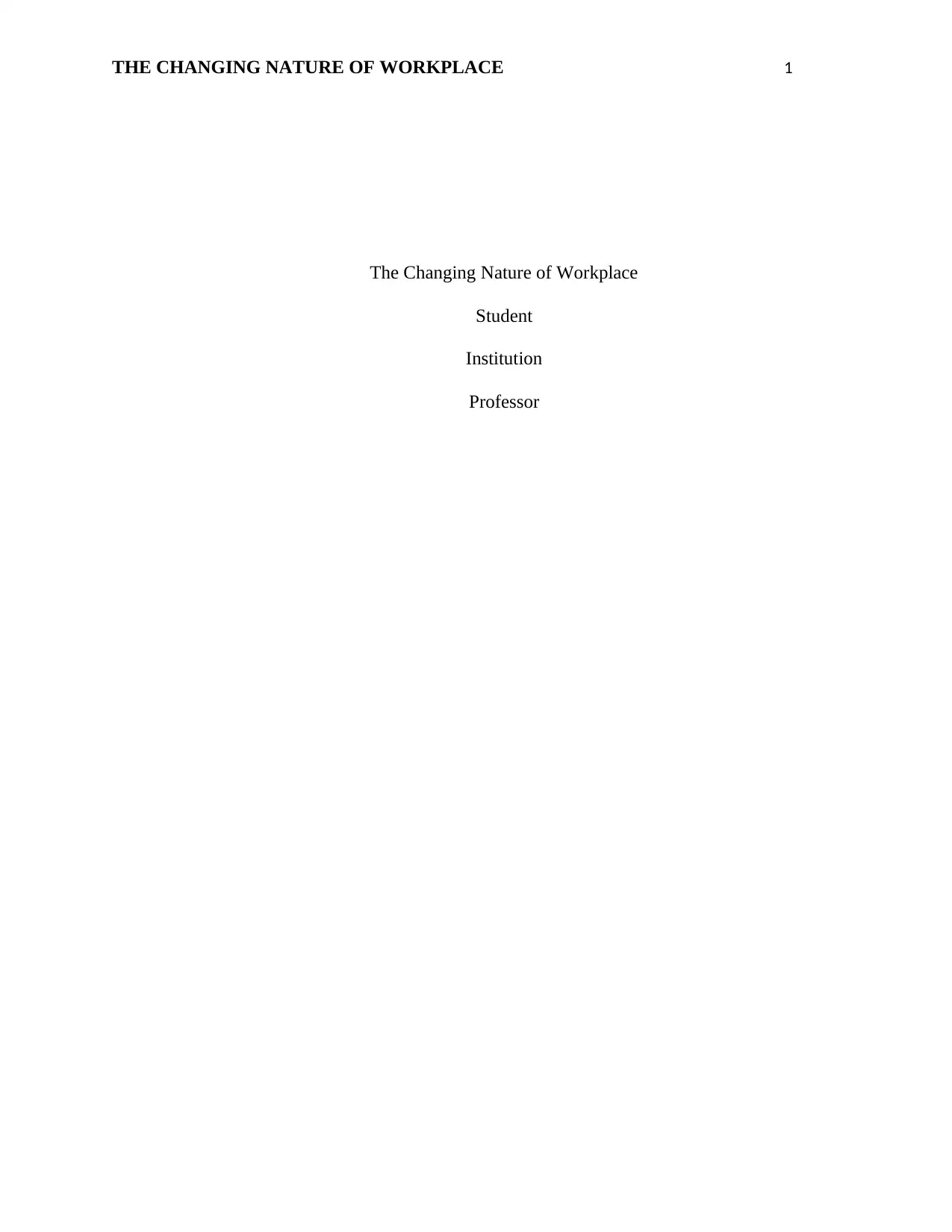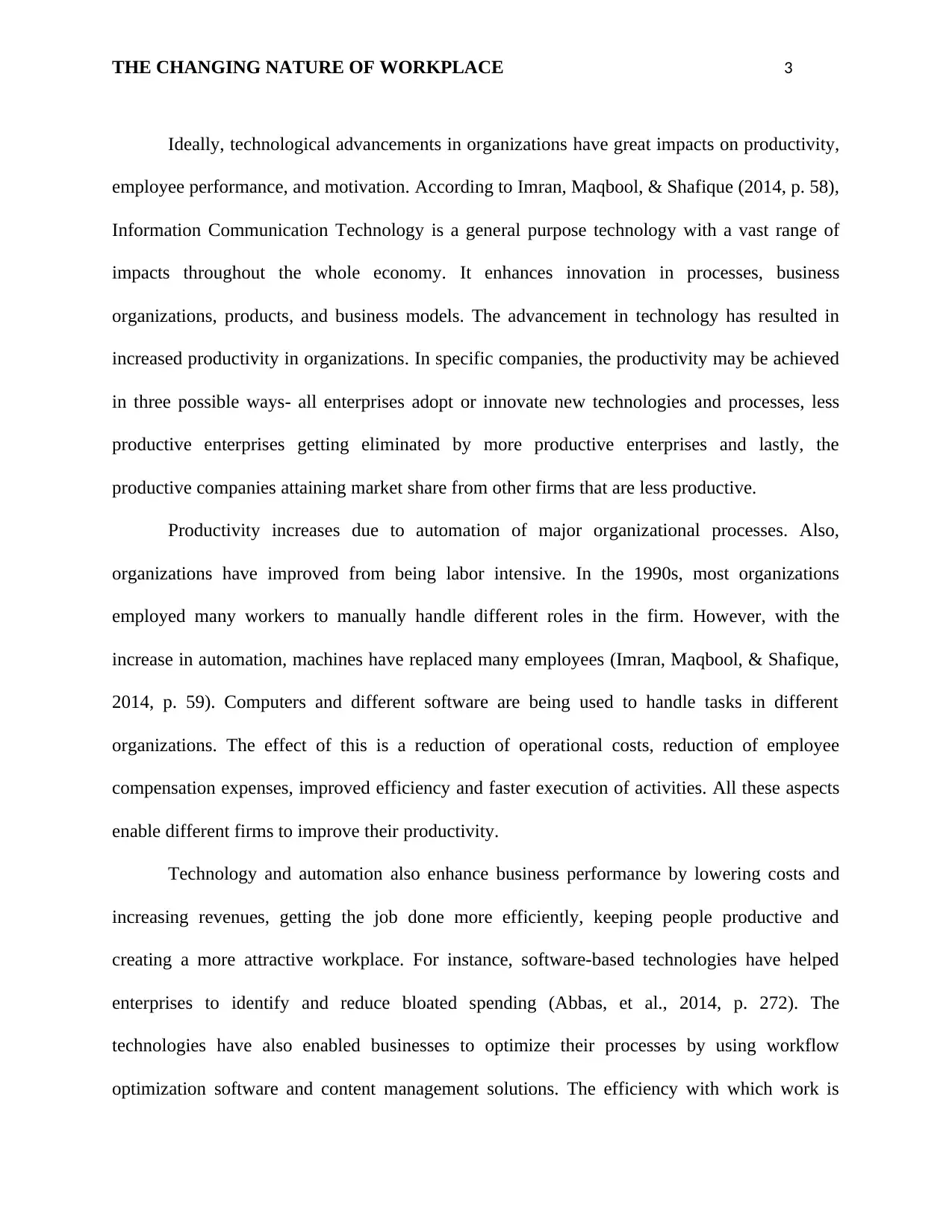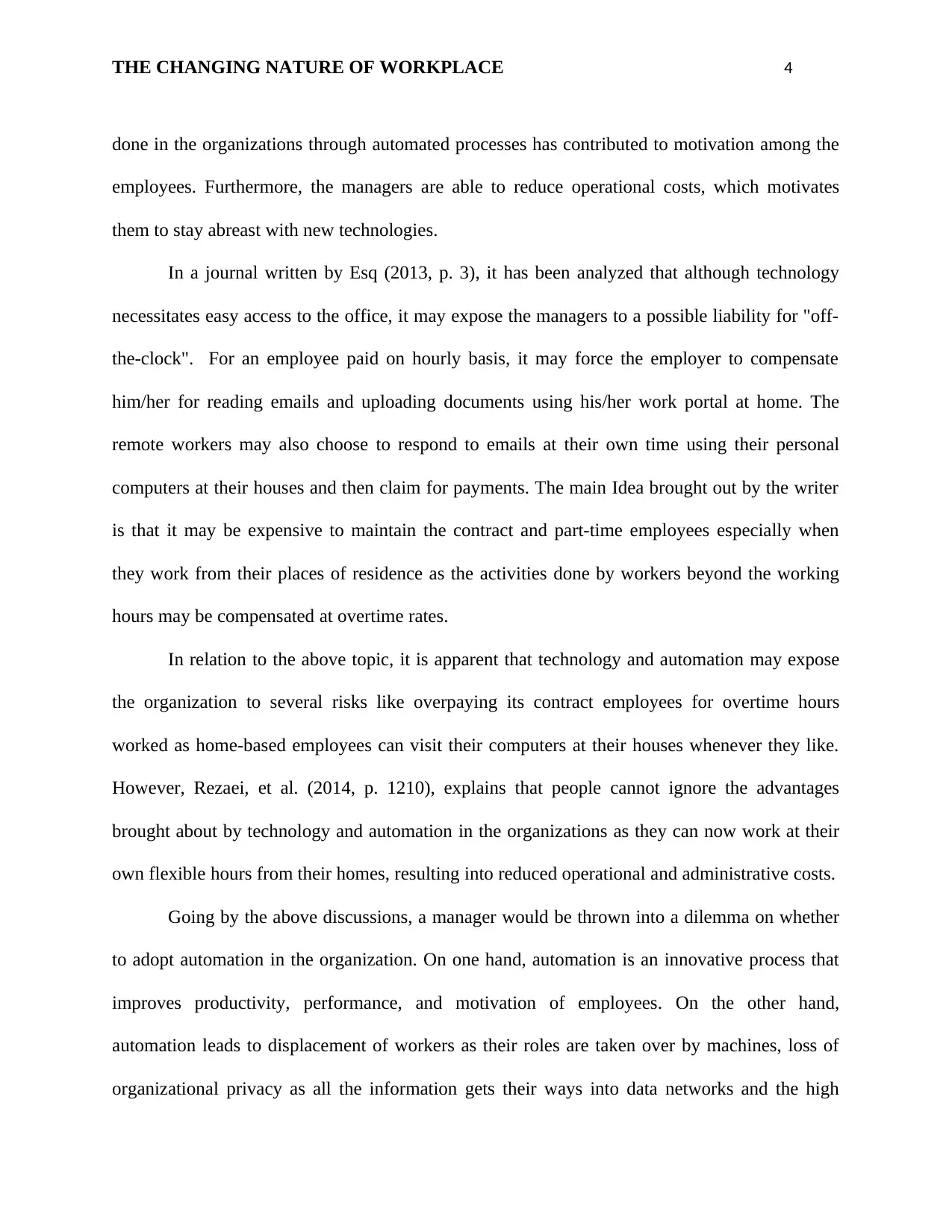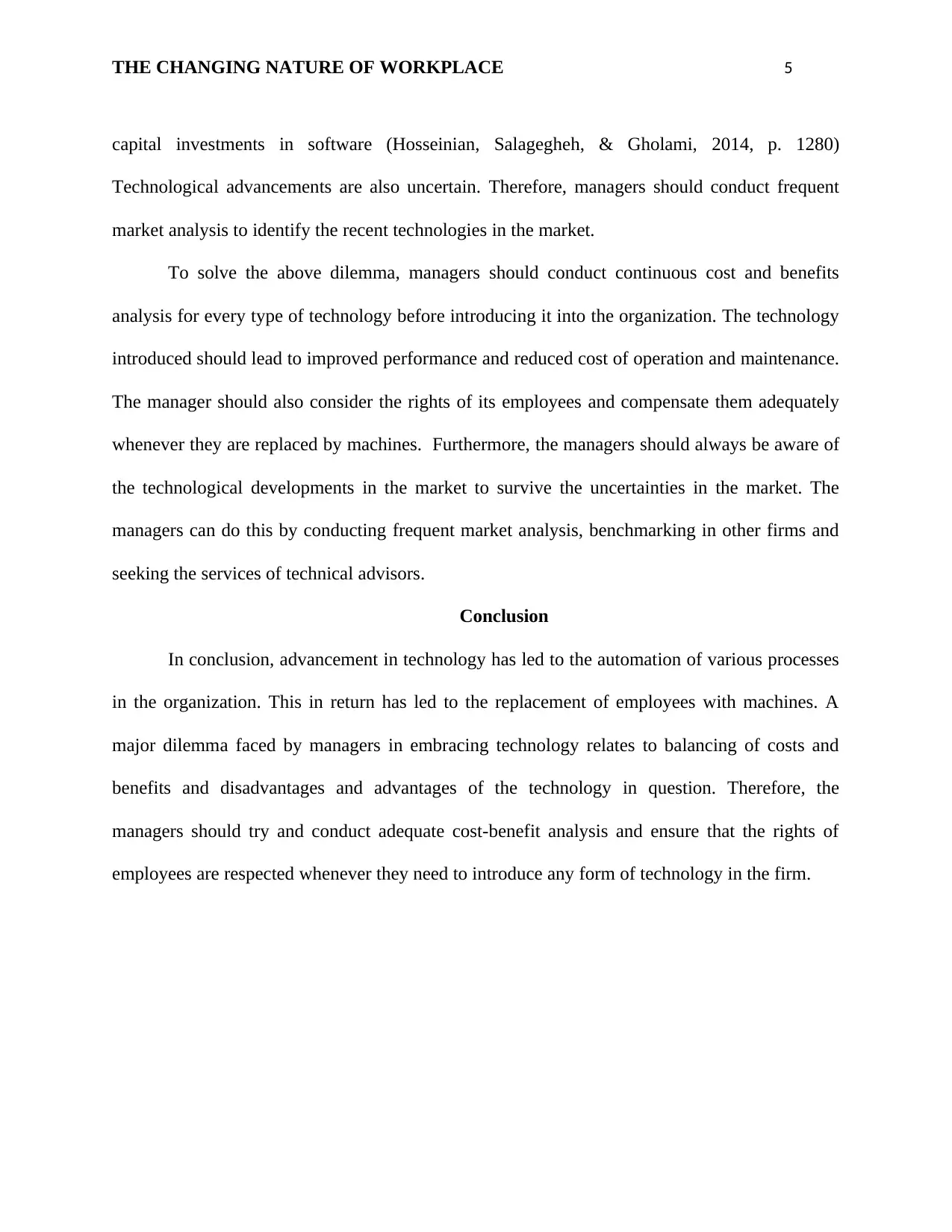Analyzing the Changing Nature of Workplace: Technology and Automation
VerifiedAdded on 2023/06/12
|6
|1551
|323
Essay
AI Summary
This essay examines the transformative effects of technology and automation on the modern workplace. It discusses the shift from traditional full-time employment to more flexible arrangements like contract and remote work, driven by advancements in artificial intelligence and robotics. The essay analyzes the implications of automation on organizational productivity, employee performance, and motivation, highlighting both the benefits, such as increased efficiency and reduced operational costs, and the challenges, including potential job displacement and the need for careful cost-benefit analysis. It also addresses the evolving nature of leadership in technology-driven environments and the importance of managers adapting to these changes by conducting market analysis and respecting employee rights. The conclusion emphasizes the need for organizations to balance the advantages and disadvantages of technology while ensuring fair treatment of their workforce.

THE CHANGING NATURE OF WORKPLACE 1
The Changing Nature of Workplace
Student
Institution
Professor
The Changing Nature of Workplace
Student
Institution
Professor
Paraphrase This Document
Need a fresh take? Get an instant paraphrase of this document with our AI Paraphraser

THE CHANGING NATURE OF WORKPLACE 2
Introduction
In 1990's the workplace was relatively stable and most of the organizations were filled
with full-time workers. However, today, there has been a decrease in the number of full-time
employees in organizations. This has been due to the fact that full-time workers are being
replaced by casual workers, contract workers, and home-based workers. Furthermore, some
firms have adopted the needs-based criterion of recruiting employees. These developments are as
a result of a continuous development of disruptive technology, which has given birth to artificial
intelligence, robotics, and machine culture.
In relation to leadership, there has been an evolution of leadership approaches. Initially,
leaders adopted transactional approaches to leadership, whereby they could physically manage
employees and monitor their activities. With the advancements in technology, leadership has
changed over time ranging from the adoption of transformational approaches which enable the
leaders to device innovative operational techniques to technology-based leadership, whereby, the
leaders need not be physically present in the offices (Cune & Fogelberg, 2012, p. 3). In
technology-based leadership, the workers work remotely. They can clock in the tasks they are
handling using technology and share Google Docs with their leaders.
Furthermore, the technological advancements in the workplace have made most
employees shift from extrinsic motivational considerations to more intrinsic motivations. Today,
employees are motivated by the flexibility in the workplace as a result of automation of
processes, rather than the material awards (Cune & Fogelberg, 2012, p. 4). Automation has made
it easier for employees to handle different tasks efficiently and by using fewer efforts. This forms
a great source of motivation to the employees.
Implications of automation
Introduction
In 1990's the workplace was relatively stable and most of the organizations were filled
with full-time workers. However, today, there has been a decrease in the number of full-time
employees in organizations. This has been due to the fact that full-time workers are being
replaced by casual workers, contract workers, and home-based workers. Furthermore, some
firms have adopted the needs-based criterion of recruiting employees. These developments are as
a result of a continuous development of disruptive technology, which has given birth to artificial
intelligence, robotics, and machine culture.
In relation to leadership, there has been an evolution of leadership approaches. Initially,
leaders adopted transactional approaches to leadership, whereby they could physically manage
employees and monitor their activities. With the advancements in technology, leadership has
changed over time ranging from the adoption of transformational approaches which enable the
leaders to device innovative operational techniques to technology-based leadership, whereby, the
leaders need not be physically present in the offices (Cune & Fogelberg, 2012, p. 3). In
technology-based leadership, the workers work remotely. They can clock in the tasks they are
handling using technology and share Google Docs with their leaders.
Furthermore, the technological advancements in the workplace have made most
employees shift from extrinsic motivational considerations to more intrinsic motivations. Today,
employees are motivated by the flexibility in the workplace as a result of automation of
processes, rather than the material awards (Cune & Fogelberg, 2012, p. 4). Automation has made
it easier for employees to handle different tasks efficiently and by using fewer efforts. This forms
a great source of motivation to the employees.
Implications of automation

THE CHANGING NATURE OF WORKPLACE 3
Ideally, technological advancements in organizations have great impacts on productivity,
employee performance, and motivation. According to Imran, Maqbool, & Shafique (2014, p. 58),
Information Communication Technology is a general purpose technology with a vast range of
impacts throughout the whole economy. It enhances innovation in processes, business
organizations, products, and business models. The advancement in technology has resulted in
increased productivity in organizations. In specific companies, the productivity may be achieved
in three possible ways- all enterprises adopt or innovate new technologies and processes, less
productive enterprises getting eliminated by more productive enterprises and lastly, the
productive companies attaining market share from other firms that are less productive.
Productivity increases due to automation of major organizational processes. Also,
organizations have improved from being labor intensive. In the 1990s, most organizations
employed many workers to manually handle different roles in the firm. However, with the
increase in automation, machines have replaced many employees (Imran, Maqbool, & Shafique,
2014, p. 59). Computers and different software are being used to handle tasks in different
organizations. The effect of this is a reduction of operational costs, reduction of employee
compensation expenses, improved efficiency and faster execution of activities. All these aspects
enable different firms to improve their productivity.
Technology and automation also enhance business performance by lowering costs and
increasing revenues, getting the job done more efficiently, keeping people productive and
creating a more attractive workplace. For instance, software-based technologies have helped
enterprises to identify and reduce bloated spending (Abbas, et al., 2014, p. 272). The
technologies have also enabled businesses to optimize their processes by using workflow
optimization software and content management solutions. The efficiency with which work is
Ideally, technological advancements in organizations have great impacts on productivity,
employee performance, and motivation. According to Imran, Maqbool, & Shafique (2014, p. 58),
Information Communication Technology is a general purpose technology with a vast range of
impacts throughout the whole economy. It enhances innovation in processes, business
organizations, products, and business models. The advancement in technology has resulted in
increased productivity in organizations. In specific companies, the productivity may be achieved
in three possible ways- all enterprises adopt or innovate new technologies and processes, less
productive enterprises getting eliminated by more productive enterprises and lastly, the
productive companies attaining market share from other firms that are less productive.
Productivity increases due to automation of major organizational processes. Also,
organizations have improved from being labor intensive. In the 1990s, most organizations
employed many workers to manually handle different roles in the firm. However, with the
increase in automation, machines have replaced many employees (Imran, Maqbool, & Shafique,
2014, p. 59). Computers and different software are being used to handle tasks in different
organizations. The effect of this is a reduction of operational costs, reduction of employee
compensation expenses, improved efficiency and faster execution of activities. All these aspects
enable different firms to improve their productivity.
Technology and automation also enhance business performance by lowering costs and
increasing revenues, getting the job done more efficiently, keeping people productive and
creating a more attractive workplace. For instance, software-based technologies have helped
enterprises to identify and reduce bloated spending (Abbas, et al., 2014, p. 272). The
technologies have also enabled businesses to optimize their processes by using workflow
optimization software and content management solutions. The efficiency with which work is
⊘ This is a preview!⊘
Do you want full access?
Subscribe today to unlock all pages.

Trusted by 1+ million students worldwide

THE CHANGING NATURE OF WORKPLACE 4
done in the organizations through automated processes has contributed to motivation among the
employees. Furthermore, the managers are able to reduce operational costs, which motivates
them to stay abreast with new technologies.
In a journal written by Esq (2013, p. 3), it has been analyzed that although technology
necessitates easy access to the office, it may expose the managers to a possible liability for "off-
the-clock". For an employee paid on hourly basis, it may force the employer to compensate
him/her for reading emails and uploading documents using his/her work portal at home. The
remote workers may also choose to respond to emails at their own time using their personal
computers at their houses and then claim for payments. The main Idea brought out by the writer
is that it may be expensive to maintain the contract and part-time employees especially when
they work from their places of residence as the activities done by workers beyond the working
hours may be compensated at overtime rates.
In relation to the above topic, it is apparent that technology and automation may expose
the organization to several risks like overpaying its contract employees for overtime hours
worked as home-based employees can visit their computers at their houses whenever they like.
However, Rezaei, et al. (2014, p. 1210), explains that people cannot ignore the advantages
brought about by technology and automation in the organizations as they can now work at their
own flexible hours from their homes, resulting into reduced operational and administrative costs.
Going by the above discussions, a manager would be thrown into a dilemma on whether
to adopt automation in the organization. On one hand, automation is an innovative process that
improves productivity, performance, and motivation of employees. On the other hand,
automation leads to displacement of workers as their roles are taken over by machines, loss of
organizational privacy as all the information gets their ways into data networks and the high
done in the organizations through automated processes has contributed to motivation among the
employees. Furthermore, the managers are able to reduce operational costs, which motivates
them to stay abreast with new technologies.
In a journal written by Esq (2013, p. 3), it has been analyzed that although technology
necessitates easy access to the office, it may expose the managers to a possible liability for "off-
the-clock". For an employee paid on hourly basis, it may force the employer to compensate
him/her for reading emails and uploading documents using his/her work portal at home. The
remote workers may also choose to respond to emails at their own time using their personal
computers at their houses and then claim for payments. The main Idea brought out by the writer
is that it may be expensive to maintain the contract and part-time employees especially when
they work from their places of residence as the activities done by workers beyond the working
hours may be compensated at overtime rates.
In relation to the above topic, it is apparent that technology and automation may expose
the organization to several risks like overpaying its contract employees for overtime hours
worked as home-based employees can visit their computers at their houses whenever they like.
However, Rezaei, et al. (2014, p. 1210), explains that people cannot ignore the advantages
brought about by technology and automation in the organizations as they can now work at their
own flexible hours from their homes, resulting into reduced operational and administrative costs.
Going by the above discussions, a manager would be thrown into a dilemma on whether
to adopt automation in the organization. On one hand, automation is an innovative process that
improves productivity, performance, and motivation of employees. On the other hand,
automation leads to displacement of workers as their roles are taken over by machines, loss of
organizational privacy as all the information gets their ways into data networks and the high
Paraphrase This Document
Need a fresh take? Get an instant paraphrase of this document with our AI Paraphraser

THE CHANGING NATURE OF WORKPLACE 5
capital investments in software (Hosseinian, Salagegheh, & Gholami, 2014, p. 1280)
Technological advancements are also uncertain. Therefore, managers should conduct frequent
market analysis to identify the recent technologies in the market.
To solve the above dilemma, managers should conduct continuous cost and benefits
analysis for every type of technology before introducing it into the organization. The technology
introduced should lead to improved performance and reduced cost of operation and maintenance.
The manager should also consider the rights of its employees and compensate them adequately
whenever they are replaced by machines. Furthermore, the managers should always be aware of
the technological developments in the market to survive the uncertainties in the market. The
managers can do this by conducting frequent market analysis, benchmarking in other firms and
seeking the services of technical advisors.
Conclusion
In conclusion, advancement in technology has led to the automation of various processes
in the organization. This in return has led to the replacement of employees with machines. A
major dilemma faced by managers in embracing technology relates to balancing of costs and
benefits and disadvantages and advantages of the technology in question. Therefore, the
managers should try and conduct adequate cost-benefit analysis and ensure that the rights of
employees are respected whenever they need to introduce any form of technology in the firm.
capital investments in software (Hosseinian, Salagegheh, & Gholami, 2014, p. 1280)
Technological advancements are also uncertain. Therefore, managers should conduct frequent
market analysis to identify the recent technologies in the market.
To solve the above dilemma, managers should conduct continuous cost and benefits
analysis for every type of technology before introducing it into the organization. The technology
introduced should lead to improved performance and reduced cost of operation and maintenance.
The manager should also consider the rights of its employees and compensate them adequately
whenever they are replaced by machines. Furthermore, the managers should always be aware of
the technological developments in the market to survive the uncertainties in the market. The
managers can do this by conducting frequent market analysis, benchmarking in other firms and
seeking the services of technical advisors.
Conclusion
In conclusion, advancement in technology has led to the automation of various processes
in the organization. This in return has led to the replacement of employees with machines. A
major dilemma faced by managers in embracing technology relates to balancing of costs and
benefits and disadvantages and advantages of the technology in question. Therefore, the
managers should try and conduct adequate cost-benefit analysis and ensure that the rights of
employees are respected whenever they need to introduce any form of technology in the firm.

THE CHANGING NATURE OF WORKPLACE 6
References
Abbas, J., Muzaffar, A., Mahmood, H. K., Ramzan, M. A., & Rizvi, S. U.-H. (2014). Impact of
Technology on Performance of Employees. World Applied Sciences Journal, 29(2),pp 271-276.
Cune, S., & Fogelberg, F. (2012). Managing Performance Remotely. Nomadic International
Business Psychology, 2(10), pp 1-16.
Esq, N. B. (2013). Then and Now: How Technology has Changed the Workplace. Hofstra Labor
and Employment Law Journal, 30(2), pp 1-24.
Hosseinian, R., Salagegheh, S., & Gholami, A. (2014). Studying The Effect of office Automation
on Managers and Employees’ Performance of Grains Company and Business Services in
Kohgilueh-Va- Boyerahmad, Fars, and Bushehr Provinces. Indian Journal of Fundamental and
Applied Life Sciences, 1(4), pp 1279-1288.
Imran, M., Maqbool, N., & Shafique, H. (2014). Impact of Technological Advancement on
Employee Performance in Banking Sector. International Journal of Human Resource Studies,
4(1), pp 57-70.
Rezaei, M., Rezaei, M., Zare, M., Akbarzadeh, H., & Zare, F. (2014). The Effects of Information
Technology (IT) on Employee Productivity in Shahr Bank (Case Study of Shiraz, Iran). Applied
mathematics in Engineering, Management and Technology, pp 1208-1214.
References
Abbas, J., Muzaffar, A., Mahmood, H. K., Ramzan, M. A., & Rizvi, S. U.-H. (2014). Impact of
Technology on Performance of Employees. World Applied Sciences Journal, 29(2),pp 271-276.
Cune, S., & Fogelberg, F. (2012). Managing Performance Remotely. Nomadic International
Business Psychology, 2(10), pp 1-16.
Esq, N. B. (2013). Then and Now: How Technology has Changed the Workplace. Hofstra Labor
and Employment Law Journal, 30(2), pp 1-24.
Hosseinian, R., Salagegheh, S., & Gholami, A. (2014). Studying The Effect of office Automation
on Managers and Employees’ Performance of Grains Company and Business Services in
Kohgilueh-Va- Boyerahmad, Fars, and Bushehr Provinces. Indian Journal of Fundamental and
Applied Life Sciences, 1(4), pp 1279-1288.
Imran, M., Maqbool, N., & Shafique, H. (2014). Impact of Technological Advancement on
Employee Performance in Banking Sector. International Journal of Human Resource Studies,
4(1), pp 57-70.
Rezaei, M., Rezaei, M., Zare, M., Akbarzadeh, H., & Zare, F. (2014). The Effects of Information
Technology (IT) on Employee Productivity in Shahr Bank (Case Study of Shiraz, Iran). Applied
mathematics in Engineering, Management and Technology, pp 1208-1214.
⊘ This is a preview!⊘
Do you want full access?
Subscribe today to unlock all pages.

Trusted by 1+ million students worldwide
1 out of 6
Related Documents
Your All-in-One AI-Powered Toolkit for Academic Success.
+13062052269
info@desklib.com
Available 24*7 on WhatsApp / Email
![[object Object]](/_next/static/media/star-bottom.7253800d.svg)
Unlock your academic potential
Copyright © 2020–2025 A2Z Services. All Rights Reserved. Developed and managed by ZUCOL.





